ToolStripItem Types in WinForms ContextMenuStrip (ContextMenuStripEx)
4 Feb 202510 minutes to read
The following are the ToolStripItems which can be added as menu items to the ContextMenuStripEx control.
- MenuItem
- TextBox
- ComboBox
- Separator
MenuItem
Represents a selectable option displayed on a MenuStrip or ContextMenuStrip. The MenuItem supports all the general properties of a ToolStripItems.
NOTE :
Please refer the link “Getting Started” section for adding MenuItem to the ContextMenuStripEx control.
The below table will explain the properties of menu item,
| Property | Description |
|---|---|
| Checked | Indicates whether the item is in the checked state. This will be displayed only if ContextMenuStripEx.ShowCheckMargin property is set to true . |
| Image | Sets the image for the menu item. This image will be displayed only when the ContextMenuStripEx.ShowImageMargin is true and DisplayStyle is Image or ImageAndText. |
| CheckedState | Specifies the check state of the item. They can be Checked, Unchecked or Indeterminate. |
| ShowShortcut keys | Indicates whether a shortcut key should be displayed in the menu item. User can access the particular menu item using this shortcut key specified in ShortcutKeys property. |
| ShortcutKeys | The shortcut key to be displayed for a menu item. |
| ShortcutKeyDisplayString | You can modify the ShortcutKey string, that is set by using the ShortcutKeyDisplayString property. |
| AutoToolTip | When set to true, will display the text set in the Text property as the item's tooltip. When set to false, will display the text set in the ToolTipText property. |
| ToolTipText | Sets the text for the tooltip when AutoToolTip is set to false. |
| DropDown | Specifies the ToolStripDropDown to be shown when the item is clicked. |
| DropDownItems | Invokes the Items Collection Editor and lets you add ToolStripItems to be displayed when the item is clicked. |
TextBox
The TextBox control is used for editable text. It is used to get input from the user at runtime.
Add a TextBox through designer
-
Once ContextMenuStripEx control is added, click Type Here for adding the TextBox. On clicking, it will display different type of ToolStripItems, using this user can choose TextBox option.

-
Once item is added, we can set the text by right-click on the particular item in the designer and select Properties. Now, in the Properties panel, under Appearance > Text we can set the text.
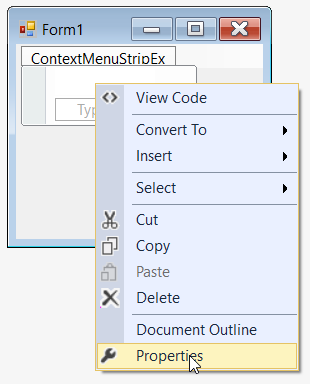

-
Finally, we have added the TextBox item in ContextMenuStripEx control successfully.
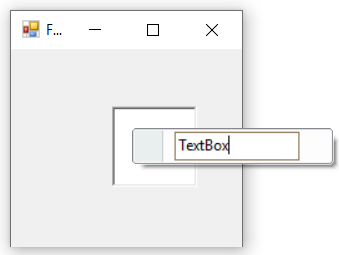
Add a TextBox through code
The below code snippet helps to add the TextBox in ContextMenuStripEx control.
//Declaration
private Syncfusion.Windows.Forms.Tools.ContextMenuStripEx contextMenuStripEx;
private System.Windows.Forms.ToolStripTextBox toolStripTextBox1;
//Initializing
this.contextMenuStripEx = new Syncfusion.Windows.Forms.Tools.ContextMenuStripEx();
this.toolStripTextBox1 = new System.Windows.Forms.ToolStripTextBox();
//Add a textbox
this.toolStripTextBox1.Text = "TextBox";
this.contextMenuStripEx1.Items.Add(this.toolStripTextBox1);'Declaration
Private contextMenuStripEx As Syncfusion.Windows.Forms.Tools.ContextMenuStripEx
Private toolStripTextBox1 As System.Windows.Forms.ToolStripTextBox
'Initializing
Me.contextMenuStripEx = New Syncfusion.Windows.Forms.Tools.ContextMenuStripEx()
Me.toolStripTextBox1 = New System.Windows.Forms.ToolStripTextBox()
'Add a textbox
Me.toolStripTextBox1.Text = "TextBox"
Me.contextMenuStripEx1.Items.Add(Me.toolStripTextBox1)
The below table explains the properties of textbox.
| Property | Description |
|---|---|
| BorderStyle | Sets the border style for the textbox. The styles available are, FixedSingle and Fixed3D (Default). |
| Lines | Let’s you open a String Collection Editor, using which multi-line text can be entered. |
| Text | Specifies the text to be displayed on the item. |
| TextBoxTextAlign | Specifies the alignment of the text inside the textbox. |
| AcceptsReturn | Indicates if return characters are accepted as input. |
| AcceptsTab | Indicates if tab characters are accepted as input. |
| CharacterCasing | Indicates if the characters should be Normal or in Upper Case or in Lower Case. |
| HideSelection | Indicates whether the selection should be hidden when the control loses focus. |
| MaxLength | Maximum number of characters that can be entered into the control. |
| ReadOnly | Indicates whether the text in the textbox is read-only. |
ComboBox
A subset of the hosted control’s properties and events are exposed at the ToolStripComboBox level, but ComboBox control is fully accessible through the ComboBox property. ToolStripComboBox is optimized for hosting in a ToolStrip.
Add a ComboBox through designer
-
Once ContextMenuStripEx control is added, click Type Here for adding the ComboBox. On clicking, it will display different type of ToolStripItems, in which choose ComboBox.
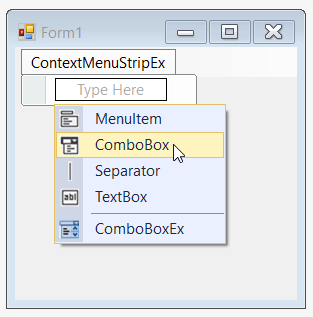
-
Once item is added, we can set the text by right-clicking on the particular item in the designer and select Properties. Now, in the Properties panel, under Appearance > Text we can set the text.
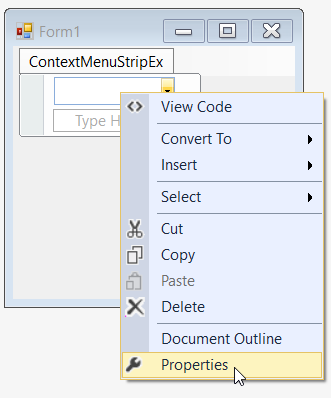

-
Similarly, we can add items collections in properties panel, under Data > Items by using String Collection Editor.
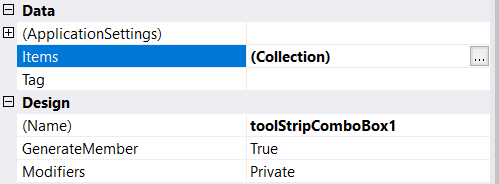
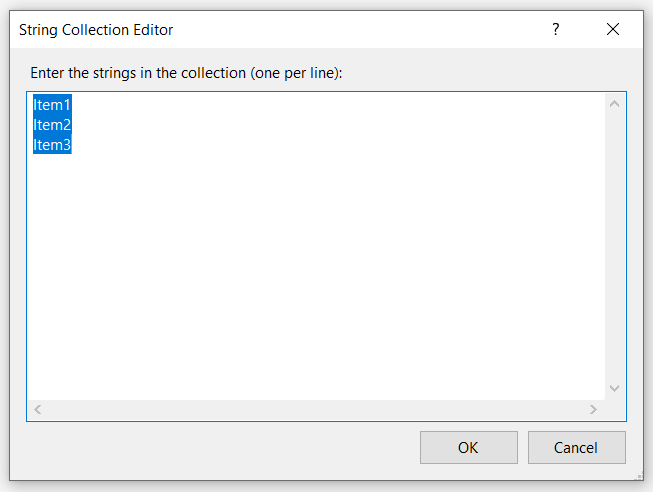
-
Finally, we have add the ComboBox in ContextMenuStripEx control successfully.
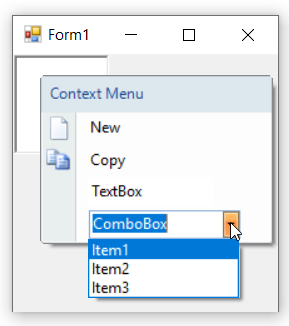
Add a ComboBox through code
The below code snippets helps to add the ComboBox in ContextMenuStripEx control.
//Declaration
private Syncfusion.Windows.Forms.Tools.ContextMenuStripEx contextMenuStripEx;
private System.Windows.Forms.ToolStripComboBox toolStripComboBox1;
//Initializing
this.contextMenuStripEx = new Syncfusion.Windows.Forms.Tools.ContextMenuStripEx();
this.toolStripComboBox1 = new System.Windows.Forms.ToolStripComboBox();
//Add a combobox
this.toolStripComboBox1.Text = "ComboBox";
this.contextMenuStripEx1.Items.Add(this.toolStripComboBox1);
this.toolStripComboBox1.Items.AddRange(new object[] { "Item1", "Item2", "Item3"});'Declaration
Private contextMenuStripEx As Syncfusion.Windows.Forms.Tools.ContextMenuStripEx
Private toolStripComboBox1 As System.Windows.Forms.ToolStripComboBox
'Initializing
Me.contextMenuStripEx = New Syncfusion.Windows.Forms.Tools.ContextMenuStripEx()
Me.toolStripComboBox1 = New System.Windows.Forms.ToolStripComboBox()
'Add a combobox
Me.toolStripComboBox1.Text = "ComboBox"
Me.contextMenuStripEx1.Items.Add(Me.toolStripComboBox1)
Me.toolStripComboBox1.Items.AddRange(New Object() { "Item1", "Item2", "Item3"})
The below table explains the properties of combobox.
| Property | Description |
|---|---|
| FlatStyle | Specifies the style of display of the control. The options are, Flat, Popup, Standard and System. |
| Items | Invokes String Collection Editor which lets you add strings list to be displayed in the combobox. |
| MaxDropDownItems | Sets the maximum number of strings that should be displayed in the dropdown. |
| MaxLength | Specifies the maximum characters that can be entered into the combobox. |
| DropDownHeight | Sets the height for the DropDown. |
| DropDownWidth | Sets the width for the DropDown. |
| IntegralHeight | Indicates whether the combobox should resize to avoid showing partial items. |
| Sorted | Specifies whether the dropdown list should be sorted. |
| AutoCompleteCustomSource | Represents the custom source of string collection for the autocomplete feature, when AutoCompleteSource property is set to CustomSource. |
| AutoCompleteSource | Represents the source of strings used for autocompletion. The sources can be, FileSystem, AllSystemSources (Default), AllUrl, CustomSource, FileSystemDirectories, HistoryList, ListItems, RecentlyUsedList and None. |
| AutoCompleteMode |
Indicates text completion behavior of the combo box. The modes are, Suggest - Displays the drop down list associated with the EditControl. This dropdown list is populated with one or more suggested completion strings,Append - Appends the reminder of the most likely candidate string to the existing character, highlighting the appended character, andSuggestAppend - Displays the drop down, also appends the highlighted string. |
Separator
Used for separation of items visually in a form. The ToolStripSeparator is automatically spaced.
Add a Separator through designer
Once ContextMenuStripEx control is added, click Type Here for adding the Separator. On clicking, it will display different type of ToolStripItems, in which choose Separator.
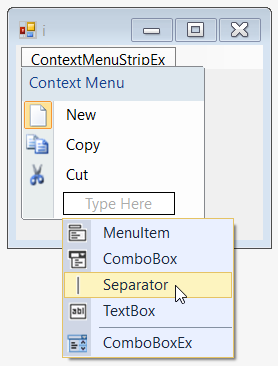
Add a Separator through code
The below code snippets adding the Separator in ContextMenuStripEx control.
//Declaration
private Syncfusion.Windows.Forms.Tools.ContextMenuStripEx contextMenuStripEx;
private System.Windows.Forms.ToolStripMenuItem toolStripMenuItem1;
private System.Windows.Forms.ToolStripMenuItem toolStripMenuItem2;
private System.Windows.Forms.ToolStripMenuItem toolStripMenuItem3;
private System.Windows.Forms.ToolStripSeparator toolStripSeparator1;
private System.Windows.Forms.ToolStripMenuItem toolStripMenuItem4;
//Initializing
this.contextMenuStripEx = new Syncfusion.Windows.Forms.Tools.ContextMenuStripEx();
this.toolStripMenuItem1 = new System.Windows.Forms.ToolStripMenuItem();
this.toolStripMenuItem2 = new System.Windows.Forms.ToolStripMenuItem();
this.toolStripMenuItem3 = new System.Windows.Forms.ToolStripMenuItem();
this.toolStripSeparator1 = new System.Windows.Forms.ToolStripSeparator();
this.toolStripMenuItem4 = new System.Windows.Forms.ToolStripMenuItem();
//Add a separator
this.toolStripMenuItem1.Image = System.Drawing.Image.FromFile(@"..\..\..\new.png");
this.toolStripMenuItem2.Image = System.Drawing.Image.FromFile(@"..\..\..\copy.png");
this.toolStripMenuItem3.Image = System.Drawing.Image.FromFile(@"..\..\..\cut.png");
this.toolStripMenuItem3.Image = System.Drawing.Image.FromFile(@"..\..\..\exit.png");
this.toolStripMenuItem1.Text = "New";
this.toolStripMenuItem2.Text = "Copy";
this.toolStripMenuItem3.Text = "Cut";
this.toolStripMenuItem3.Text = "Exit";
this.contextMenuStripEx.Items.AddRange(new System.Windows.Forms.ToolStripItem[] {
this.toolStripMenuItem1,
this.toolStripMenuItem2,
this.toolStripMenuItem3,
this.toolStripSeparator1,
this.toolStripMenuItem4});'Declaration
Private contextMenuStripEx As Syncfusion.Windows.Forms.Tools.ContextMenuStripEx
Private toolStripMenuItem1 As System.Windows.Forms.ToolStripMenuItem
Private toolStripMenuItem2 As System.Windows.Forms.ToolStripMenuItem
Private toolStripMenuItem3 As System.Windows.Forms.ToolStripMenuItem
Private toolStripSeparator1 As System.Windows.Forms.ToolStripSeparator
Private toolStripMenuItem4 As System.Windows.Forms.ToolStripMenuItem
'Initializing
Me.contextMenuStripEx = New Syncfusion.Windows.Forms.Tools.ContextMenuStripEx()
Me.toolStripMenuItem1 = New System.Windows.Forms.ToolStripMenuItem()
Me.toolStripMenuItem2 = New System.Windows.Forms.ToolStripMenuItem()
Me.toolStripMenuItem3 = New System.Windows.Forms.ToolStripMenuItem()
Me.toolStripSeparator1 = New System.Windows.Forms.ToolStripSeparator()
Me.toolStripMenuItem4 = New System.Windows.Forms.ToolStripMenuItem()
'Add a Separator
Me.toolStripMenuItem1.Image = System.Drawing.Image.FromFile("..\..\..\new.png")
Me.toolStripMenuItem2.Image = System.Drawing.Image.FromFile("..\..\..\copy.png")
Me.toolStripMenuItem3.Image = System.Drawing.Image.FromFile("..\..\..\cut.png")
Me.toolStripMenuItem3.Image = System.Drawing.Image.FromFile("..\..\..\exit.png")
Me.toolStripMenuItem1.Text = "New"
Me.toolStripMenuItem2.Text = "Copy"
Me.toolStripMenuItem3.Text = "Cut"
Me.toolStripMenuItem3.Text = "Exit"
Me.contextMenuStripEx.Items.AddRange(New System.Windows.Forms.ToolStripItem() { Me.toolStripMenuItem1, Me.toolStripMenuItem2, Me.toolStripMenuItem3, Me.toolStripSeparator1, Me.toolStripMenuItem4})Finally, we have added separator in ContextMenuStripEx control successfully.
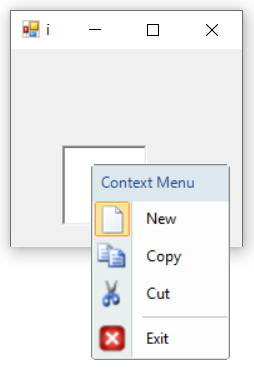
The below table explains the properties of Separator.
| Property | Description |
|---|---|
| BackColor | Sets the back color for the separator. |
| ForeColor | Sets the fore color for the separator. |
| AutoSize | Determines whether the item should automatically size based on its image and text. |
| Visible | Sets the visibility of the separator. |